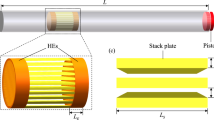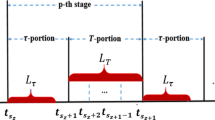Abstract
This paper proposes an H-infinity combustion control method for diesel engines. The plant model is the discrete dynamics model developed by Yasuda et al., which is implementable on a real engine control unit. We introduce a two-degree-of-freedom control scheme with a feedback controller and a feedforward controller. This scheme achieves both good feedback properties, such as disturbance suppression and robust stability, and a good transient response. The feedforward controller is designed by taking the inverse of the static plant model, and the feedback controller is designed by the H-infinity control method, which reduces the effect of the trubocharger lag. The effectiveness of the proposed method is evaluated in simulations using the nonlinear discrete dynamics model.
Similar content being viewed by others
References
H. Xie, S. Li, K. Song, et al. Model-based decoupling control of VGT and EGR with active disturbance rejection in diesel engines. IFAC Proceedings Volumes, 2013, 46(21): 282–288.
A. G. Stefanopoulou, I. Kolmanovsky, J. S. Freudenberg. Control of variable geometry turbocharged diesel engines for reduced emissions. IEEE Transactions on Control Systems Technology, 2000, 8(4): 733–745.
G. H. Abd-Alla. Using exhaust gas recirculation in internal combustion engines: a review. Energy Conversion and Management, 2002, 43(8): 1027–1042.
D. Schiefer, D. Maennel, W. Nardoni. Advantages of Diesel Engine Control Using In-Cylinder Pressure Information for Closed Loop Control. SAE Technical Paper 2003-01-0364. Detroit: SAE International,2003.
G. D. Neely, S. Sasaki, Y. Huang, et al. New Diesel Emisson Control Strategy to Meet US Tier 2 Emissions Regulations. SAE Technical Paper 2005-01-1091. Detroit: SAE International,2005.
A. M. Kulkarni, K. C. Stricker, A. Blum, et al. PCCI Control Authority of a Modern Diesel Engine Outfitted With Flexible Intake Valve Actuation. SAE Technical Paper 2009-01-18882. Detroit: SAE International,2009.
A. E. Ctania, S. d’ Ambrosio, R. Finesso, et al. Combustion system optimization of a low compression-ratio PCCI diesel engine for light-duty application. SAE International Journal of Engines, 2009, 2(1): 1314–1326.
T. Ishikawa, N. Horibe. Characteristics and problems of dieselbase PCCI combustion. Marine Engineering, 47(6): 859–864 (in Japanese).
L. Guzzella, C. H. Onder. Introduction to Modeling and Control of Internal Combustion Engine Systems. Berlin: Springer,2010.
M. Iwadare, M. Ueno, Y. Hattori, et al. Modeling and control systems design by model predictive control for air-path system of diesel engine. Transactions of the Society of Instrument and Control Engineers, 2010, 46(8): 456–462 (in Japanese).
K. Yasuda, Y. Yamasaki, S. Kaneko, et al. Diesel combustion model for on-board application. International Journal of Engine Research, 2016, 17(7): 748–765.
H. Shimizu, K. Hoshida, Y. Nakamura, et al. Discrete dynamics model for diesel combustion: expansion of the model to multiinjection (two-stage injection). 2nd report. Proceedings of the 25th Internal Combustion Engine Symposium. Tokyo, 2014 (in Japanese).
K. Zhou, J. C. Doyle. Essentials of Robust Control. Englewood Cliffs: Prentice Hall,1998.
T. Yamaguchi, M. Hirata, C. K. Pang. High-Speed Precision Motion Control. New York: CRC Press,2012.
P. Apkarian, P. Gahinet, G. Backer. Self-scheduled H8 control of linear parameter-varying system–a design example. Automatica, 1998, 31(9): 1251–1261.
Author information
Authors and Affiliations
Corresponding author
Additional information
This work was supported by “Innovative Combustion Technology” of a cross-ministerial strategic innovation promotion program (SIP) under Japan Science and Technology Agency (JST).
Mitsuo HIRATA received B.E., M.E., and Ph.D. degrees from Chiba University in 1991, 1993, and 1996, respectively. From 1996 through 2004, he was a Research Associate in the Department of Electronics and Mechanical Engineering, Chiba University. From 2002 through 2003, he was a Visiting Scholar in the Department of Mechanical Engineering, University of California, Berkeley. Since June 2004, he has been at Utsunomiya University, where he is currently a Professor of the Department of Electrical and Electronic Systems Engineering. His research interests include robust control, high-precision motion control, sampled-data control, and their applications to industrial systems. He is a member of IEEE, SICE, ISCIE, IEEJ, and JSME.
Sota ISHIZUKI received the B.E. and M.E. degrees from National Institute of Technology, Nagaoka College and Utsunomiya University in 2015 and 2017, respectively. His current research interest is advanced control of combustion in diesel engines.
Masayasu SUZUKI received the B.E., M.E., and Ph.D. degrees in Aerospace Engineering from Nagoya University, Nagoya, Japan, in 2005, 2007, and 2010, respectively. From 2010 to 2013, he was a Post-Doctoral researcher of FIRST Aihara Innovative Mathematical Modelling Project, Japan Science and Technology Agency, in the Department of Mechanical and Environmental Informatics, Tokyo Institute of Technology. Since December 2013, he has been with the Department of Electrical and Electronic Systems Engineering, Utsunomiya University, where he is currently an Assistant Professor. His research interests include control of nonlinear systems, control of distributed parameter systems, and network structure identification. He is a member of IEEE, SICE, ISCIE, IEEJ, JSME and IEICE.
Rights and permissions
About this article
Cite this article
Hirata, M., Ishizuki, S. & Suzuki, M. Two-degree-of-freedom H-infinity control of combustion in diesel engine using a discrete dynamics model. Control Theory Technol. 15, 109–116 (2017). https://doi.org/10.1007/s11768-017-6144-8
Received:
Revised:
Accepted:
Published:
Issue Date:
DOI: https://doi.org/10.1007/s11768-017-6144-8




